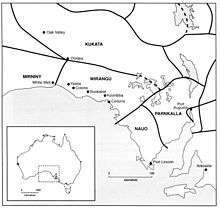Wirangu language
The Wirangu language is a moribund Australian Aboriginal language traditionally spoken by the Wirangu people, living on the west coast of South Australia across a region encompassing modern Ceduna and Streaky Bay, stretching west approximately to the head of the Great Australian Bight and east to Lake Gairdner.
| Wirangu | |
|---|---|
| Native to | Australia |
| Region | West coast of South Australia |
| Ethnicity | Wirangu people |
| Extinct | 2 semi-speakers reported in 2007[1] |
Pama–Nyungan
| |
| Language codes | |
| ISO 639-3 | wgu |
| Glottolog | wira1265[2] |
| AIATSIS[3] | C1 |
 Tribal boundaries, after Tindale (1974), adapted from Hercus (1999) | |
The Wirangu language is most closely related to the Thura–Yura group of Australian Aboriginal languages, which are spoken from the West Coast to the Adelaide area and north to the Flinders Ranges and Lake Eyre. The best-known relatives of Wirangu are Barngarla, Nukunu, Adnyamathanha, Narangga and Kaurna. Because of the intensive culture contacts in the southern half of South Australia, which brought dislocation and culture change, traditional lifeways and traditional ways of speaking declined during the nineteenth and twentieth centuries. In the case of Wirangu, the establishment of the Koonibba mission in 1898 brought intense contact with other languages, in particular Kokatha. As all languages spoken in South Australia are ultimately derived from the same ancestor, they share a common inheritance of grammar, lexicon and pronunciation. Moreover, neighbouring languages often borrow words from one another, and the new intense contacts at Koonibba led to a significant influx of Kokatha words which have become part of present-day Wirangu. Although there are very few fully fluent Wirangu speakers left, many Aboriginal people in the Ceduna area remember parts of the language.
A Wirangu language revitalization program has been underway at Ceduna and surrounding areas since 2004. This has involved the recording of Wirangu language from the last two recognized full speakers of the language, Gladys and Doreen Miller. With the assistance of linguists from the University of Adelaide a number of printed and digital books have been produced for use in schools and in the wider community. In 2005 the Far West Languages Centre was established in Ceduna. The Centre supports and promotes the use of the Wirangu language as well as other extremely endangered local languages, such as Gugada/Kokatha and Mirning.
Classification
Wirangu is a Pama–Nyungan language, closely related to other neighboring Thura–Yura languages in the east such as Parnkalla and Nauo. Wirangu also appears to have borrowed several lexical items from the Kukata people, who lived to the north of the Wirangu.
Phonology
Vowels
Wirangu has three phonemic vowels (a, i, u). Vowel length is not usually considered phonemic in Wirangu, as vowel length is normally short, although it is predictably long in all monosyllabic words (Wirangu 'ma' [ma:], 'wa' [wa:], 'mil' [mi:l], etc.), borrowings from other languages ('maatha' [ma:t̪a] < English "master"), and cases of initial consonant loss across phonological boundaries ('marna' + '(k)artu' = 'marnaartu' [maɳa:ʈu]).
| Front | Back | |
|---|---|---|
| High | i | u |
| Low | a | |
Consonants
The consonantal phonemic inventory of Wirangu is very similar to that of many other Pama Nyungan languages, with six series of stops and nasals. Voicing is not phonemic in the Wirangu stop series, and many stops are either unvoiced or semivoiced.[4] Wirangu also has two rhotics, an alveolar flap/trill and a more retroflex rhotic.
| Peripheral | Laminal | Apical | |||||
|---|---|---|---|---|---|---|---|
| Labial | Velar | Dental | Palatal | Alveolar | Retroflex | ||
| Stop | p | k | t̪ | c | t | ʈ | |
| Nasal | m | ŋ | n̪ | ɲ | n | ɳ | |
| Lateral | l̪ | ʎ | l | ɭ | |||
| Flap or Trill | r | ||||||
| Approximant | w | j | ɻ | ||||
Notes
- Wirangu at Ethnologue (18th ed., 2015)
- Hammarström, Harald; Forkel, Robert; Haspelmath, Martin, eds. (2017). "Wirangu". Glottolog 3.0. Jena, Germany: Max Planck Institute for the Science of Human History.
- C1 Wirangu at the Australian Indigenous Languages Database, Australian Institute of Aboriginal and Torres Strait Islander Studies
- Hercus, pp. 26; L.A. Hercus uses the voiced stop equivalents "b", "d", "g", etc. in her orthography.
Further reading
- Hercus, L.A. (1999). A Grammar of the Wirangu Language from the West Coast of South Australia (PDF). Pacific Linguistics Series C, Volume 150. Canberra: Pacific Linguistics. doi:10.15144/pl-c150. hdl:1885/146617. ISBN 978-0-85883-505-4.CS1 maint: ref=harv (link)
- Miller, Gladys (2005). "Wardugu Wirn: Hunting for Wombat". University of Adelaide. ISBN 0-9757912-0-6.